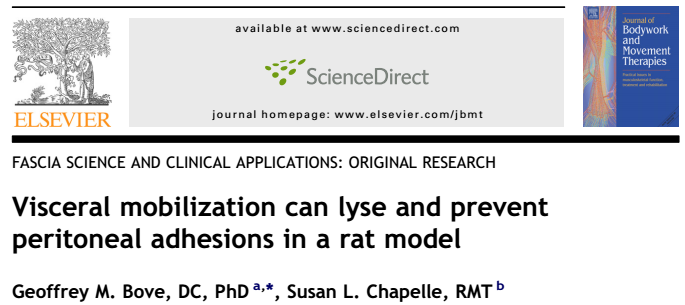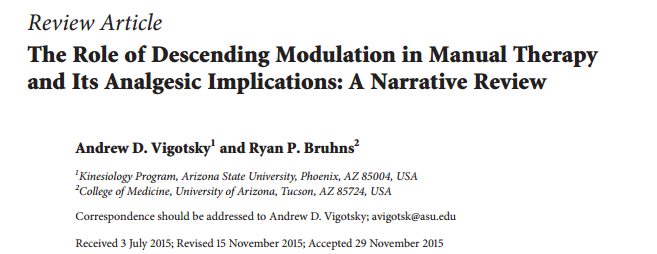10 Articles All Massage Therapists Should Read
/Evidence Based Resources for Massage Therapist
The RMT Education Project provides massage therapists resources to simplify the complex -by taking a intensive processes and break it down in to manageable chunks. If you are looking for a somewhere to start, check out the ‘Curated Content’ page or browse through ‘The Massage Therapy Literature Review’. Here we break down a list of ten articles all massage therapists should be aware of.
The Massage Therapy Literature Countdown
• 10 Articles All Massage Therapists Should Read
• 9 Open Access Articles for Massage Therapists
• 8 Researchers Who Are Changing Massage Therapy
• 7 Books For Massage Therapists
• 6 Blogs For Massage Therapists
• 5 Systematic Reviews of Massage Therapy
• 4 Articles About The Importance of Touch
• 3 Bones You May Not Have Heard About
• 2 Peer-reviewed Publications for Massage Therapists
• 1 Book That Will Change The Way You Think
Open Access Resources
• Curated Resources for Massage Therapists
• Open Access Research Papers
• Resources for Patients
Research Review
• A New Muscle: The Tensor Vastus Intermedius
• Pleasure Receptors Response to Massage
• Does Fascia Release
• Evidence Informed Massage
Ten Article For Evidence Informed Massage Therapists
ONE
Myofascial Trigger Points Then and Now: A Historical and Scientific Perspective (2015).
- This is the most recent narrative review of myofascial triggerpoints authored by Jay Shah.
From The Conclusion...
"To date, the pathogenesis and pathophysiology of MTrPs and their role in MPS remain unknown. Data have been published suggesting that MPS is a pain syndrome that can be acute or chronic, and that it involves muscle and fascia. The MTrP remains central to its diagnosis, and possibly its successful treatment. New methods of describing and imaging the MTrP as well as the milieu of the MTrP have suggested that there are a variety of objective findings associated with the syndrome and active MTrPs."
"Earlier theories for the pathogenesis of MTrPs and MPS, including muscle overuse and mechanical difficulties, remain current and have been neither proved nor disproved."
"Many questions remain to be answered. For example, what is the etiology and pathophysiology of MPS? What is the role of the MTrP in the pathogenesis of MPS? Is the resolution of the MTrP required for clinical response? What is the mechanism by which the pain state begins, evolves, and persists? Although the presence of pro-inflammatory and noxious biochemicals has been established, what are the levels of anti-inflammatory substances, analgesic substances, and muscle metabolites in the local biochemical milieu of muscle with and without MTrPs? How does a tender nodule progress to a myofascial pain syndrome? Which musculoskeletal tissues are involved, what are their properties, and how do these change in response to treatment? These are some of the questions that researchers must address in the future. Proper treatment of MPS requires identification and targeting of the mechanisms and pathophysiology of perpetuating factors to obtain sustained relief."
TWO
Manual therapy as an effective treatment for fibrosis in a rat model of upper extremity overuse injury (2016).
- This is a very recent research paper that provides a proof of concept of the role massage therapy may play in the attenuation of fibrosis. Researchers used Modeled Manual Therapy (MMT) which consisted of gentle mobilization, skin rolling, and muscle stripping/myofascial release to the forearm flexor compartment; joint mobilization of the wrist; and stretching combined with long superficial strokes of the entire upper limb.
From The Conclusion...
"Our results show that a multimodal intervention designed to emulate manual therapy, applied in the early stages of symptom development, prevents functional declines, improves task performance, and prevents behavioral changes indicative of discomfort during task performance. The results also show that MMT (Modeled Manual Therapy) attenuated the increased fibrosis that characterizes this model and that is associated with the sensorimotor declines, as well as the tissue and serum levels of TGF-β1, a key fibrogenic factor. Thus, manual therapy may be an effective preventative for MSDs by decreasing tissue fibrosis. Such research promises to shed light on the pathophysiology of WMSDs but more importantly, has the potential to translate into effective prophylactic treatments for people suffering from these common and often debilitating disorders."
THREE
Massage therapy attenuates inflammatory signaling after exercise-induced muscle damage (2012).
- This research article provides an overview on the effects of massage therapy on inflammation.
From The Discussion...
"The increasing use of massage therapy as an adjunct to conventional care for musculoskeletal injury recovery (1) and the growing number of physician referrals for massage (26) represent a shift toward non–drug-based therapies for personal health. Given the spiraling cost of primary care and medications in the United States, it is likely that more patients will seek out this therapy as well as other nontraditional medical alternatives to complement more conventional approaches to their healthcare. In particular, because musculoskeletal problems have a significant impact on daily function and quality of life, it is important to validate treatments that enhance recovery, moderate inflammation, and reduce pain in skeletal muscle. To begin this process, we have assessed the molecular influence of massage on human muscle cells and determined that muscle damaged by exercise is responsive to a 10-min session of massage. After activating cellular signaling pathways through mechanotransduction, massage attenuated the rise in several other signaling pathways indicative of muscle inflammation and cell stress regulated by NFκB and also augmented signaling through PGC-1α."
FOUR
Clinical relevance of fascial tissue and dysfunctions (2014).
- This article provides an overview of fascial tissue from a clinical perspective.
Concluding Clinical Perspectives...
"In research studies oriented around soft tissue pain, the dominant emphasis has been on the examination of neuromuscular processes. Recent advances in the rapidly evolving field of fascia research suggest that pathological changes in fibrous collagenous connective tissues (fasciae) could additionally play a contributing role in several myofascial pain syndromes. These encompass conditions characterized by altered stiffness of related fascial tissues and/or by a decrease in their sliding ability or shearing motion (see Table 1).
A better understanding of the cellular dynamics involved in fibrosis promises to enrich the range of therapeutically available options. Manual myofascial therapies, as well as specifically targeted fascial movement therapies, may be able to assist in the process of improving matrix remodeling. For example, myofascial abdominal massage has been shown to reduce intra-abdominal adhesions in rats [54], and in vitro application of a super slow fluid shear motion was able to induce the increased expression of matrix metalloproteinase-1, a potent antifibrotic enzyme [55]. Advances in ultrasound imaging (including sonographic elastography) and in myometry promise to become helpful tools in the assessment of pathological, as well as therapeutically induced, changes in fascial tissue properties associated with many myofascial pain syndromes rats [56, 57]."
FIVE
Fascia—Current knowledge and future directions in physiatry: Narrative review (2014).
- This is a well written narrative review of the fascial system.
- This article is available for free online.
From The Discussion & Conclusion...
"Fascia is continuous throughout the body, supporting various functions [8,12– 13]. Its continuity aids in force transmission both longitudinally and epimuscularly [14–16]. Through mechanotransduction, these forces may be transmitted at a cellular level, altering gene expression of fibroblasts and thereby changing the extracellular matrix composition [26–28]. Repetitive mechanical straining of fibroblasts can also result in secretion of inflammatory mediators [29]. All of these changes could affect the normal functions of force transmission or sliding in the musculoskeletal system. This dysfunction could lead to pain or proprioceptive issues, considering that fascia has been shown to be innervated [41–44]. Thus, treatment of disorders affecting the musculoskeletal system may need to be focused on this fascial network."
SIX
Pain (2012).
- This is an overview of pain and the pain matrix from Ronald Melzack.
From The Conclusion...
"We have traveled a long way from the psychophysical concept that seeks a simple one-to-one relationship between injury and pain. We now have a theoretical framework in which a genetically determined template for the body-self is modulated by the powerful stress system and the cognitive functions of the brain, in addition to the traditional sensory inputs. The neuromatrix theory of pain—which places genetic contributions and the neural-hormonal mechanisms of stress on a level of equal importance with the neural mechanisms of sensory transmission—has important implications for research and therapy. An immediate recommendation is that interdisciplinary pain clinics should expand to include specialists in endocrinology and immunology. Such a collaboration may lead to insights and new research strategies that may reveal the underlying mechanisms of chronic pain and give rise to new therapies to relieve the tragedy of unrelenting suffering associated with needless pain."
SEVEN
Is neuroplasticity in the central nervous system the missing link to our understanding of chronic musculoskeletal disorders? (2015).
- This open access article that will help therapists develop their understanding of neuroplasticity as it applies to pain.
- This article is available for free online.
From The Summary...
"Recent findings suggest that a change in model and approach is required in the rehabilitation of chronic MSD that integrate the findings of neuroplastic changes across the CNS and are targeted by rehabilitative interventions. Effects of current interventions may be mediated through peripheral and central changes but may not specifically address all underlying neuroplastic changes in the CNS potentially associated with chronic MSD. Novel approaches to address these neuroplastic changes show promise and require further investigation to improve efficacy of currents approaches."
EIGHT
A critical evaluation of the trigger point phenomenon (2014).
- This review paper made waves in 2015 by calling into question long held theories about myofascial triggerpoints
From The Conclusion...
"The construct of MPS caused by TrPs remains conjecture. All working hypotheses derived from this conjecture have been refuted and therefore the theory can be discarded. In contrast, evolving insights into the neurobiology of nociception and pain suggest plausible hypotheses that form a basis for advancing knowledge and therapeutics in this challenging area."
NINE
Visceral mobilization can lyse and prevent peritoneal adhesions in a rat model (2012).
- This is the first research article to show the effect of massage therapy on post surgical adhesions.
From The Conlusion...
"These initial observations support visceral mobilization may have a role in the prevention and treatment of post-operative adhesions."
TEN
The Role of Descending Modulation in Manual Therapy and Its Analgesic Implications: A Narrative Review (2015).
- This open access review article talks about the pain modulatory effects of manual therapy.
- This article is available for free online.
From The Conclusion...
"Nearly all types of manual therapy have been shown to elicit a neurophysiological response that is associated with the descending pain modulation circuit; however, it appears that different types of manual therapy work through different mechanisms (Table 1). For example, while massage therapy appears to elicit an oxytocin response, spinal manipulation does not. It is crucial that more higher quality research be performed to better understand these mechanisms, as it can lead to a better understanding of how each therapy can be applied to drive more specific clinical research."
I hope this list gives you as a therapists a good overview of the content available out there. I would love to hear some recommendations for what I articles I should include in my next list! Let me know in the comments or on twitter.
10 research articles, all massage therapists should read! #triggerpoints, #myofascialrealease #painscience #massage
https://t.co/ErTtfwmeJO
— Richard Lebert (@adaptivetherapy) January 15, 2016










